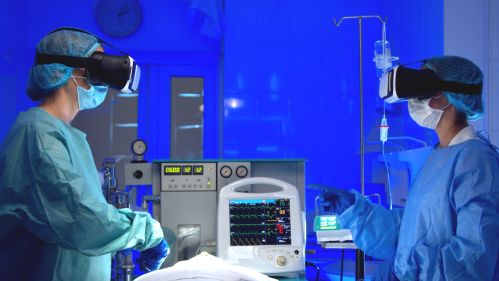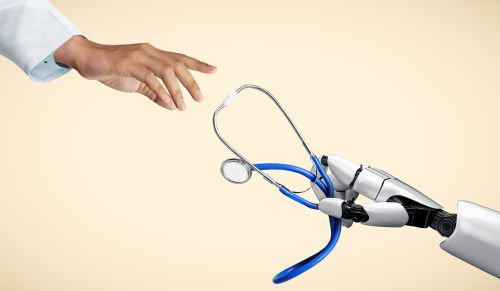The operation on the back using virtual reality was carried out on Tuesday, November 7, at the hospital of the University of Montpellier. This is the first such operation in the world.
This Tuesday in the operating room of Gui-de-Chauliac, in Montpellier, it was quite intense, and this is not surprising, given the fact that such an operation has never been carried out in the world. However, even such a tense atmosphere could not unsettle the “junior surgeon”, who operated with virtual reality glasses for the first time in his life.
Spinal osteosynthesis via virtual reality at the University Hospital of Montpellier
The operation, spinal osteosynthesis, includes the fixation of several vertebrae to stabilize them and is considered ordinary. It was a sixty-year-old patient suffering from chronic back pain.
In addition to his gloves, his mask, and his traditional blue blouse, the surgeon was wearing a special device. For the first time, open surgery was performed using mixed reality.
The intern was equipped with a pair of futuristic glasses, which allowed him, when he looked down, to see the patient naturally, under general anesthesia but as soon as he lifted his head, he sees a lot of useful information, including video tutorials, to guide his actions during the operation.
During the operation, all the surgeon’s actions were accurate, they went successively one after another. From time to time, a neurosurgeon raised his head or turned it from side to side. These movements allowed him to see better the necessary information…
“This device makes it possible to add medical information during an operating procedure. Information that, theoretically, is on a computer. It is a real help during the intervention, “says neurosurgeon Nicolas Lonjon.
Revinax, which makes immersive tutorials in virtual reality from real images, made this world premiere possible. “The work we are doing today aims to match the patient’s imagery with the operation being performed,” says Maxime Ros, a former chief of the University Hospital of Montpellier. He has developed this innovative device.
In other words, perhaps the surgeon could one day follow the procedure previously modeled on each patient as a seamstress can follow the contours of a pattern.
The device could also be useful in terms of training students, not only in theory but also in practice that includes surgery, says the University Hospital of Montpellier, which is never the last when it comes to innovations of any kind.

Occitanie is fertile soil for medical innovation in Montpellier
What should medical personnel do in case of a brilliant idea, an innovative project that arose during a conversation between the trustees? – Implement them or not? “Many people have ideas but they do not put them into practice,” recalls Guillaume Duchaffaut, deputy general director of the Hospital of the University of Montpellier.
“We help to move from an idea to innovation, implemented and becoming a regular practice.”
“Our health professionals are not familiar with the process of creating startups, as they work in the field of healthcare and are far from business. This can lead to mistakes, so you have to be careful and cautious”, sounds the official position of the medical facility. To prevent a “brain drain”, in early 2017 the facility created an “extractor of innovations”. His principle is “The special group meets the ideas in the services”, in order to avoid abandoning projects.
In addition to tracking, the idea is also to “help move from invention to industrial innovation.” To this end, we linked them with local structures to support entrepreneurship and innovation, such as AxLR or Transfert LR. We provide them with intellectual protection, assistance in creating a brand … there was not all this assistance in the hospital at all”, Guillaume Duchaffaut recalls.
In partnership with the University Hospital of Montpellier
A university hospital may be involved or not, sometimes it is a simple partner, as in the case of Maxim Ros, the former head of the clinic, who launched his company. Dr. Ros has now resigned from the hospital to dedicate himself to business, and the University Hospital is following the project development process.
“Most often, when doctors start a business, they trust it with the third person … they are doctors, after all!” – says Guillaume Duchaffaut. In the city of Montpellier, which has made health a showcase of French technology, in the territory full of good ideas, there are more and more interesting offers. Diag2TEC, e-Dentech, Spot to Lab, Omunis, or Aviitam – they are called “the fruits of fruitful cooperation between all participants in this territory.”

Innovations at the University Hospital of Montpellier
Professor Antoine Avignon, Head of the Nutrition and Diabetes Unit at the University Hospital of Montpellier, and Dr. Vincent Attalin, co-founders of Aviitam, developed an “intelligent health book”, a platform developed at the University of Montpellier, which facilitates the dissemination of information about overweight patients among health professionals. Nicolas Giraudeau, the research professor at the dental center of the University Hospital of Montpellier, introduced a remote solution for dental consultations.
In the Cap Omega manager, Diag2TEC introduces innovations in the individual treatment of multiple myeloma, leukemia. In this case, the startup unites teams from the University Hospital and the Institute of Human Genetics. Also, it’s worth mentioning Cap Omega, accompanied by Bic, Spot to Lab with an innovative blood drive kit for detecting hepatitis B, C, and HIV. It was developed by two physicians: Jacques Ducos, a virologist at the Lapeyronie Hospital, and his colleague Sylvain Lehmann, director of the Saint-Eloi Biotechnology Research Institute.
The article is made on materials of Midi Libre.





